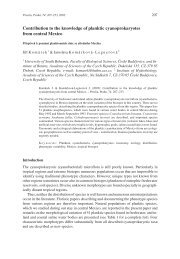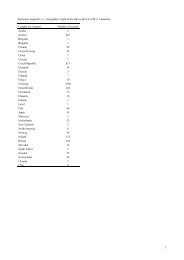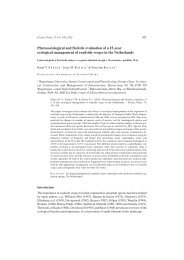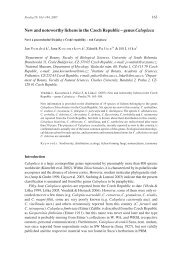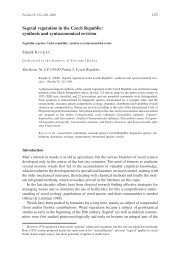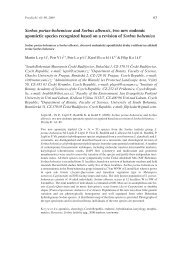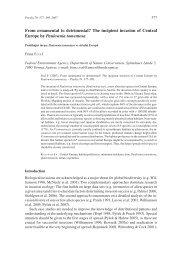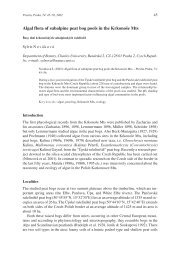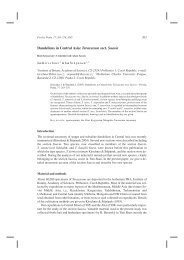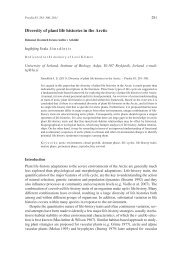The habitat factors that affect the composition of bryophyte and ...
The habitat factors that affect the composition of bryophyte and ...
The habitat factors that affect the composition of bryophyte and ...
Create successful ePaper yourself
Turn your PDF publications into a flip-book with our unique Google optimized e-Paper software.
Preslia 78: 67–86, 2006 67<br />
<strong>The</strong> <strong>habitat</strong> <strong>factors</strong> <strong>that</strong> <strong>affect</strong> <strong>the</strong> <strong>composition</strong> <strong>of</strong> <strong>bryophyte</strong> <strong>and</strong> lichen<br />
communities on fallen logs<br />
Jaké faktory ovlivňují složení společenstev mechorostů a lišejníků na padlých kmenech?<br />
Irena J a n s o v á * & Zdeněk S o l d á n<br />
Department <strong>of</strong> Botany, Faculty <strong>of</strong> Sciences, Charles University, Benátská 2, CZ-128 01<br />
Praha, Czech Republic. – * Present address: Auf Pünten 29, CH-8405 Winterthur, Switzerl<strong>and</strong>,<br />
e-mail: irena_vac@hotmail.com<br />
Jansová I. & Soldán Z. (2006): <strong>The</strong> <strong>habitat</strong> <strong>factors</strong> <strong>that</strong> <strong>affect</strong> <strong>the</strong> <strong>composition</strong> <strong>of</strong> <strong>bryophyte</strong> <strong>and</strong> lichen<br />
communities on fallen logs. – Preslia 78: 67–86.<br />
<strong>The</strong> <strong>composition</strong> <strong>of</strong> cryptogam (<strong>bryophyte</strong> <strong>and</strong> lichen) communities on fallen logs was studied in<br />
two old-growth forests in <strong>the</strong> Czech Republic. Altoge<strong>the</strong>r, 85 species (22 liverworts, 44 mosses, <strong>and</strong><br />
19 lichens) were recorded. <strong>The</strong> presence <strong>and</strong> abundance <strong>of</strong> <strong>the</strong> different species on 350 logs was attributed<br />
to <strong>habitat</strong> <strong>factors</strong> (e.g. humidity, wood decay, wood s<strong>of</strong>tness, log diameter, bark cover,<br />
thickness <strong>of</strong> humus layer <strong>and</strong> tree species) <strong>that</strong> were recorded separately for each <strong>of</strong> <strong>the</strong> logs. <strong>The</strong><br />
aim was to identify <strong>the</strong> <strong>factors</strong> significantly <strong>affect</strong>ing <strong>the</strong> <strong>composition</strong> <strong>of</strong> cryptogam communities.<br />
For <strong>the</strong> different ecological groups <strong>of</strong> species (epiphytes, epixylic species, <strong>and</strong> ground flora) forwarded<br />
canonical correspondence analysis (CCA) selected thickness <strong>of</strong> humus layer <strong>and</strong> tree species<br />
as <strong>the</strong> <strong>factors</strong> explaining most variability. In addition, <strong>the</strong> extent <strong>of</strong> log surface covered by bark,<br />
humidity <strong>and</strong> log decay were selected as significant determinants <strong>of</strong> cryptogam community<br />
<strong>composition</strong>.<br />
K e y w o r d s : <strong>bryophyte</strong>s, Czech Republic, dead wood, epixylic species, lichens, old-growth forest,<br />
species <strong>composition</strong><br />
Introduction<br />
Dead wood is an important component <strong>of</strong> temperate forests. St<strong>and</strong>ing dead trees (snags),<br />
fallen logs <strong>and</strong> large branches <strong>and</strong> stumps form major structural features <strong>of</strong> ecological importance.<br />
<strong>The</strong>y serve as <strong>habitat</strong>s for various organisms, represent a source <strong>of</strong> mineral nutrients<br />
<strong>and</strong> energy <strong>and</strong> influence soil movement <strong>and</strong> deposition (Harmon et al. 1986). <strong>The</strong><br />
importance <strong>of</strong> decaying logs for different groups <strong>of</strong> organisms has been intensively studied,<br />
mostly in <strong>the</strong> boreal zone (Samuelsson et al. 1994, Essen et al. 1997). Harmon et al.<br />
(1986) <strong>and</strong> Eckl<strong>of</strong>f & Ziegeler (1991) have reviewed <strong>the</strong> ecological roles <strong>of</strong> dead wood in<br />
different parts <strong>of</strong> <strong>the</strong> temperate zone.<br />
Dead wood is an important <strong>habitat</strong> for <strong>bryophyte</strong>s <strong>and</strong> lichens. Some species live exclusively<br />
on dead wood (obligate or true epixylic species), o<strong>the</strong>rs grow on logs <strong>and</strong> stumps as<br />
well as on o<strong>the</strong>r substrates (facultative epixylic species). Generally, <strong>the</strong> importance <strong>of</strong><br />
dead wood for <strong>bryophyte</strong>s is revealed by comparing <strong>the</strong> <strong>composition</strong> <strong>of</strong> <strong>bryophyte</strong>s on<br />
logs <strong>and</strong> stumps in forests <strong>of</strong> different ages. Greater numbers <strong>of</strong> <strong>bryophyte</strong> species occur in<br />
old forests, with a continuous supply <strong>of</strong> logs in various stages <strong>of</strong> decay than in young or<br />
managed forests, where <strong>the</strong> amount <strong>and</strong> quality <strong>of</strong> dead wood is limited (Andersson &<br />
Hytteborn 1991, Lesica et al. 1991, Crites & Dale 1998, Rambo & Muir 1998, Ódor &<br />
St<strong>and</strong>ovár 2001, Desponts et al. 2002). <strong>The</strong> air humidity is substantially higher in old for-
68 Preslia 78: 67–86, 2006<br />
ests than in managed forests. This seems to be important for obligate epixylic species,<br />
namely tiny <strong>and</strong> drought-sensitive liverworts, which are mostly restricted to old forests<br />
(Söderström 1988a, Laaka 1993, Vellak & Paal 1999).<br />
<strong>The</strong> <strong>composition</strong> <strong>of</strong> <strong>the</strong> <strong>bryophyte</strong> <strong>and</strong> lichen communities on logs mirrors <strong>the</strong><br />
successional changes in <strong>the</strong> physical <strong>and</strong> chemical properties <strong>of</strong> <strong>the</strong> wood during its decay,<br />
such as texture, density, s<strong>of</strong>tness, pH <strong>and</strong> water-holding capacity (McCullogh 1948,<br />
Muhle & LeBlanc 1975, Cornelissen & Karssemeijer 1987, Crites & Dale 1998, Ódor &<br />
Van Hees 2004). <strong>The</strong> <strong>composition</strong> <strong>of</strong> <strong>bryophyte</strong>s <strong>and</strong> lichens is also reportedly <strong>affect</strong>ed by<br />
<strong>the</strong> tree species (Ježek 1959, Nakamura 1987, Stefureac 1987, McAlister 1997) <strong>and</strong> log diameter<br />
(Söderström 1988b, Andersson & Hytteborn 1991, Ódor & Van Hees 2004). <strong>The</strong><br />
preferences <strong>of</strong> individual <strong>bryophyte</strong> species for stages <strong>of</strong> decay, surface texture, wood<br />
s<strong>of</strong>tness <strong>and</strong> log diameter are presented by Söderström (1988b). For example, <strong>the</strong> liverwort<br />
Anastrophyllum hellerianum occurs mostly on very large logs with no bark <strong>and</strong> hard<br />
wood. Noteworthy, some species <strong>of</strong> lichens (such as Hypogymnia physodes) <strong>affect</strong> <strong>the</strong> decay<br />
<strong>of</strong> logs thus contributing to <strong>the</strong> formation/conservation <strong>of</strong> <strong>the</strong>ir <strong>habitat</strong>s (Rypáček<br />
1966, Henningsson & Lundstöm 1970, Lundstöm & Henningsson 1973). This is probably<br />
not <strong>the</strong> case for <strong>bryophyte</strong>s.<br />
Most authors have previously related species <strong>composition</strong> to <strong>the</strong> above mentioned environmental<br />
<strong>and</strong> substrate <strong>factors</strong> individually. However, since those <strong>factors</strong> are inherently<br />
dependent on each o<strong>the</strong>r, it is imperative to take into account possible intercorrelations between<br />
those <strong>factors</strong>. This requires an appropriate analysis <strong>of</strong> <strong>the</strong> data (which is by nature<br />
multivariate) in order to identify <strong>the</strong> <strong>factors</strong> explaining <strong>the</strong> greatest proportions <strong>of</strong> <strong>the</strong><br />
variability in species <strong>composition</strong>.<br />
This study focuses on <strong>the</strong> <strong>composition</strong> <strong>of</strong> <strong>bryophyte</strong> <strong>and</strong> lichen communities on fallen<br />
logs in two remnants <strong>of</strong> old beech-fir forests in <strong>the</strong> Novohradské hory Mts, in SE Czech<br />
Republic. Both forests have a similar history <strong>and</strong> are integrated into larger forest-covered<br />
areas <strong>and</strong> declared reserves with a strict ban on logging in 1838. <strong>The</strong>y differ in area <strong>and</strong><br />
moisture conditions, <strong>the</strong> Ž<strong>of</strong>ínský prales being about 10 times larger <strong>and</strong> damper than <strong>the</strong><br />
smaller <strong>and</strong> drier Hojná voda forest (Průša 1985).<br />
<strong>The</strong> following questions were addressed: (i) Does <strong>the</strong> <strong>composition</strong> <strong>of</strong> cryptogams on<br />
logs differ in <strong>the</strong>se two old forests <strong>that</strong> differ in dampness? (ii) Which <strong>of</strong> <strong>the</strong> <strong>habitat</strong> <strong>factors</strong><br />
determine <strong>the</strong> <strong>composition</strong> <strong>of</strong> cryptogams on fallen logs? (iii) Which <strong>of</strong> <strong>the</strong> <strong>habitat</strong> <strong>factors</strong><br />
determine <strong>the</strong> species <strong>composition</strong> <strong>of</strong> <strong>the</strong> different ecological groups <strong>of</strong> cryptogams? (iv)<br />
What are <strong>the</strong> preferences <strong>of</strong> <strong>the</strong> individual species <strong>of</strong> cryptogams for <strong>the</strong>se <strong>factors</strong>?<br />
Methods<br />
Study sites<br />
This study took place in two old forests in <strong>the</strong> Novohradské Hory Mts in <strong>the</strong> south-eastern<br />
part <strong>of</strong> Bohemia near <strong>the</strong> Czech-Austrian border. <strong>The</strong>se forests are <strong>the</strong> oldest protected<br />
natural reserves in <strong>the</strong> Czech Republic, both established in 1838. <strong>The</strong>y represent remnants<br />
<strong>of</strong> fir-beech mountain forest vegetation indigenous to <strong>the</strong> locality <strong>and</strong> illustrate <strong>the</strong> dynamics<br />
<strong>of</strong> a change in <strong>the</strong> tree layer. Nowadays, <strong>the</strong> dominant tree species is beech (Fagus<br />
sylvatica L., 79%) followed by spruce, Picea abies (L.) Karst. (15%). <strong>The</strong> originally dom-
Jansová & Soldán: Bryophyte <strong>and</strong> lichen communities on fallen logs 69<br />
inant fir (Abies alba Mill.) currently represents only 5% <strong>of</strong> <strong>the</strong> tree layer. Maple (Acer<br />
platanoides L. <strong>and</strong> A. pseudoplatanus L.) <strong>and</strong> elm (Ulmus glabra Huds.) are scarce (under<br />
1%). Trees are <strong>of</strong> different dimensions <strong>and</strong> ages (from 20 to 400 years), <strong>and</strong> logs are in different<br />
stages <strong>of</strong> decay (Průša 1990). <strong>The</strong> region lies at <strong>the</strong> transition between oceanic <strong>and</strong><br />
continental climates. <strong>The</strong> climate is cold <strong>and</strong> wet, mean annual temperature is 5.5°C <strong>and</strong><br />
annual precipitation ranges from 800 to 950 mm (Průša 1985).<br />
<strong>The</strong> Ž<strong>of</strong>ínský prales forest is located at 48°39'42" to 48°40'22" N <strong>and</strong> 14°42'02" to<br />
14°43'03" E at an altitude <strong>of</strong> between 735 <strong>and</strong> 825 m a.s.l. It covers 97.71 ha (Průša 1985).<br />
Different forest types form an heterogeneous mosaic; this is a typical feature <strong>of</strong> <strong>the</strong> reserve.<br />
Relatively abundant springs <strong>and</strong> brooks reflect <strong>the</strong> moist conditions in <strong>the</strong> mostly<br />
shaded understorey. <strong>The</strong> total number <strong>of</strong> <strong>bryophyte</strong> species recently recorded on all types<br />
<strong>of</strong> substrates in <strong>the</strong> reserve is 185 (Vacínová 1998, Kučera 2004). Currently, <strong>the</strong>re are 46<br />
epiphytic <strong>and</strong> epixylic species <strong>of</strong> lichen in this forest (Peksa et al. 2004).<br />
<strong>The</strong> essentially smaller <strong>and</strong> sunnier Hojná voda forest is situated on a slope, 810 to 880<br />
m a.s.l. at 48°42'30" N <strong>and</strong> 14°45'30" E. Its area covers 9 ha (Vyskot 1981). This forest<br />
represents relatively drier <strong>habitat</strong> with a small area <strong>of</strong> springs. 90 <strong>bryophyte</strong> species are recently<br />
recorded in <strong>the</strong> reserve area (Vacínová 1998, Kučera 2004). Currently, 12 epiphytic<br />
<strong>and</strong> epixylic lichens species are recorded in this forest (Peksa et al. 2004).<br />
Field sampling<br />
Fallen logs, at least 1 m long with diameter equal to or above 15 cm, were sampled, omitting<br />
stumps <strong>and</strong> snags. In <strong>the</strong> smaller forest, Hojná voda, all such logs found within <strong>the</strong> old<br />
forest were surveyed. In <strong>the</strong> Ž<strong>of</strong>ínský prales forest all such logs along a ten-meter wide<br />
NNE to SSW transect, through <strong>the</strong> old forest were examined. One plot <strong>of</strong> 0.04 m 2 (ei<strong>the</strong>r<br />
square 20 × 20 cm or rectangle 10 × 40 cm) was sampled on each log. Rectangular plots<br />
were used on logs <strong>of</strong> smaller diameter, where <strong>the</strong> use <strong>of</strong> square plots would prevent <strong>the</strong><br />
sampling <strong>of</strong> areas with approximately homogenous slopes. <strong>The</strong> sample plot area (0.04 m 2 )<br />
is <strong>the</strong> largest approximately homogenous area (chosen with regard to <strong>habitat</strong> <strong>factors</strong>)<br />
found on a heterogeneous substrate such as decaying logs (I. Jansová, unpublished data).<br />
<strong>The</strong> sample plot was chosen r<strong>and</strong>omly on each log. Presence <strong>and</strong> abundance <strong>of</strong> <strong>bryophyte</strong>s<br />
<strong>and</strong> lichens was recorded in <strong>the</strong>se plots between May <strong>and</strong> September 1997. Abundance<br />
classes used in this study are shown in Table 1. <strong>The</strong> species <strong>that</strong> were not identified in <strong>the</strong><br />
field were collected <strong>and</strong> identified later. Voucher specimens are stored in PRC herbarium.<br />
For each log sampled, certain environmental <strong>and</strong> substrate characteristics (henceforth referred<br />
to as <strong>habitat</strong> <strong>factors</strong>) were recorded: Substrate type <strong>of</strong> four levels, depends on species<br />
<strong>of</strong> tree: beech, spruce, fir <strong>and</strong> o<strong>the</strong>r trees including uncommon elm <strong>and</strong> maple species as well<br />
as a few indeterminable logs. <strong>The</strong> four levels <strong>of</strong> substrate type were treated as dummy variables<br />
throughout this study. <strong>The</strong>refore, <strong>the</strong>y are treated as four single <strong>factors</strong>. Logs without<br />
bark were identified to species with <strong>the</strong> help <strong>of</strong> <strong>the</strong> original map <strong>of</strong> fallen trees (Průša 1990)<br />
<strong>and</strong> by consulting <strong>the</strong> local forester (B. Švarc, pers. comm.). Recorded frequencies <strong>of</strong> individual<br />
substrate types are presented in Fig. 1. Slope, with values varying from 0 (top) to 180°<br />
(bottom <strong>of</strong> <strong>the</strong> log), <strong>and</strong> slope orientation <strong>of</strong> <strong>the</strong> sample plot ei<strong>the</strong>r to <strong>the</strong> north (Northward)<br />
or east (Eastward) (each with values 1, 0, –1). Thickness <strong>of</strong> humus layer on <strong>the</strong> log was measured<br />
in <strong>the</strong> sample plot. Canopy was estimated as percentage <strong>of</strong> <strong>the</strong> area <strong>of</strong> <strong>the</strong> log overshadowed.<br />
Diameter <strong>of</strong> <strong>the</strong> log was measured for <strong>that</strong> part <strong>of</strong> <strong>the</strong> log on which <strong>the</strong> sample
70 Preslia 78: 67–86, 2006<br />
Table 1. – Abundance scale used in assessing <strong>bryophyte</strong> <strong>and</strong> lichen cover on <strong>the</strong> sample plots (0.04m 2 ). Mean<br />
class value (in %) was used in multivariate analyses.<br />
Class Fraction <strong>of</strong> plot area covered Mean class value (%)<br />
1 Some individuals to 1/100 1<br />
2 1/100 to 1/16 3.5<br />
3 1/16 to 1/8 9.8<br />
4 1/8 to 1/4 19<br />
5 1/4 to 1/2 38<br />
6 1/2 to 1 75.5<br />
was taken. Decay was measured using a semi-quantitative scale modified from Söderström<br />
(1988b) as follows: (1) freshly fallen log, hard, whole, bark intact, branches present; (2) log<br />
solid, wood hard, more than 50% <strong>of</strong> bark present; (3) some patches <strong>of</strong> s<strong>of</strong>t wood, more than<br />
50% <strong>of</strong> bark missing; (4) wood s<strong>of</strong>tening, outline retained, bark missing; (5) log outline<br />
slightly deformed; (6) pieces <strong>of</strong> s<strong>of</strong>t wood, log outline still distinguishable; (7) only log core<br />
remains; (8) log outline indeterminable, humification 100%, no evidence <strong>of</strong> hard wood. Decay<br />
refers to <strong>the</strong> condition <strong>of</strong> <strong>the</strong> whole log. Recorded frequencies <strong>of</strong> individual decay<br />
classes are presented in Fig. 2. Characteristics <strong>of</strong> <strong>the</strong> log surface (Texture) was also recorded<br />
using a semi-quantitative scale modified from Söderström (1988b) as follows: (0) bark intact;<br />
(1) smooth surface without bark; (2) small crevices; (3) crevices <strong>and</strong> rills, rough surface;<br />
(4) small pieces <strong>of</strong> wood missing; (5) large pieces <strong>of</strong> wood missing, surface irregular,<br />
large depressions; (6) humidified chippings <strong>of</strong> wood, surface still distinguishable; (7) surface<br />
indeterminable. Recorded frequencies <strong>of</strong> individual texture classes are presented in<br />
Fig. 3. Wood s<strong>of</strong>tness was measured as <strong>the</strong> thickness <strong>of</strong> <strong>the</strong> s<strong>of</strong>t wood layer in centimetres<br />
Fig. 1. – Frequency <strong>of</strong> substrate types (tree species) in Ž<strong>of</strong>ínský prales (n = 268) <strong>and</strong> Hojná voda (n = 82) forests.
Jansová & Soldán: Bryophyte <strong>and</strong> lichen communities on fallen logs 71<br />
Fig. 2. – Frequency <strong>of</strong> different decay stages <strong>of</strong> logs (1 – freshly fallen log, hard, whole, bark intact, branches present;2–logsolid,<br />
wood hard, more than 50% <strong>of</strong> bark present; 3 – some patches <strong>of</strong> s<strong>of</strong>t wood, more than 50% <strong>of</strong><br />
bark missing; 4 – wood s<strong>of</strong>tening, outline retained, bark missing; 5 – log outline slightly deformed; 6 – pieces <strong>of</strong><br />
s<strong>of</strong>t wood, log’s outline still distinguishable; 7 – only log core remains; 8 – log’s outline indeterminable,<br />
humification 100%, no evidence <strong>of</strong> hard wood) in Ž<strong>of</strong>ínský prales (n = 268) <strong>and</strong> Hojná voda (n = 82) forests.<br />
Fig. 3. – Frequency <strong>of</strong> texture classes <strong>of</strong> logs (0 – bark intact; 1 – smooth surface without bark; 2 – small crevices;<br />
3 – crevices <strong>and</strong> rills, rough surface; 4 – small pieces <strong>of</strong> wood missing; 5 – large pieces <strong>of</strong> wood missing, surface<br />
irregular, large depressions; 6 – humidified woody chippings, surface still distinguishable; 7 – surface indeterminable)<br />
in Ž<strong>of</strong>ínský prales (n = 268) <strong>and</strong> Hojná voda (n = 82) forests.
72 Preslia 78: 67–86, 2006<br />
<strong>and</strong> is <strong>the</strong> mean <strong>of</strong> three measurements on <strong>the</strong> sample plot. “S<strong>of</strong>t” wood was penetrable or<br />
removable with fingers. Contact <strong>of</strong> <strong>the</strong> log with <strong>the</strong> ground was estimated as a percentage <strong>of</strong><br />
<strong>the</strong> log length. Above ground height was measured at <strong>the</strong> highest point <strong>of</strong> <strong>the</strong> elevated log<br />
from <strong>the</strong> ground. Bark cover was estimated as a percentage <strong>of</strong> <strong>the</strong> log surface. Presence or<br />
absence <strong>of</strong> branches was also recorded. Mean values <strong>of</strong> individual <strong>habitat</strong> <strong>factors</strong> are shown<br />
in Table 2.<br />
Data analysis<br />
Bryophytes <strong>and</strong> lichens were subdivided into three ecological groups: epiphytes (species<br />
commonly found on living trees), epixylic species (typically found on rotting wood) <strong>and</strong><br />
ground flora (optimal <strong>habitat</strong> <strong>the</strong> ground). Species were subdivided into <strong>the</strong>se groups after<br />
comparison with o<strong>the</strong>r studies (Söderström 1988b, Laaka 1993, Söderström 1993, Crites<br />
& Dale 1998). Some species, not mentioned in <strong>the</strong> above studies, were assigned to <strong>the</strong><br />
groups according to Vacínová (1998). O<strong>the</strong>r species (e.g. Brachy<strong>the</strong>cium species), which<br />
occurred more frequently on o<strong>the</strong>r substrates than fallen logs at <strong>the</strong> studied sites<br />
(I. Vacínová, unpublished data) were assigned to ecological groups according to <strong>the</strong>ir substrate<br />
preferences at <strong>the</strong> studied sites (Vacínová 1998).<br />
In <strong>the</strong> set <strong>of</strong> 17 <strong>factors</strong> <strong>the</strong>re were 3 environmental (Eastward, Northward, Canopy) <strong>and</strong><br />
14 substrate characteristics. During sampling it became evident <strong>that</strong> <strong>the</strong> <strong>habitat</strong> <strong>factors</strong> could<br />
be intercorrelated. Strongly correlated variables bring no independent information about<br />
species <strong>composition</strong> <strong>and</strong> may be excluded from <strong>the</strong> analysis; retaining only one factor from<br />
<strong>the</strong> intercorrelated group <strong>of</strong> <strong>factors</strong> is usually sufficient for an analysis (ter Braak 1986). To<br />
determine such possible intercorrelations among <strong>habitat</strong> <strong>factors</strong> in this study, <strong>the</strong> centred <strong>and</strong><br />
st<strong>and</strong>ardized analysis <strong>of</strong> principal components (PCA) was used. In this case, values <strong>of</strong> all<br />
<strong>factors</strong> (disregarding <strong>the</strong> Locality) were used as species in PCA. Factors such as Texture<br />
(correlated with Decay stage), Contact, Height, Branches (all correlated with Bark), Spruce<br />
(correlated to Beech), <strong>and</strong> O<strong>the</strong>r trees (correlated with Fir) were omitted from fur<strong>the</strong>r analyses<br />
due to <strong>the</strong>ir strong intercorrelation with remaining <strong>factors</strong> (analysis not shown).<br />
Ordination techniques were used to explore <strong>the</strong> relationships between <strong>the</strong> <strong>composition</strong><br />
<strong>of</strong> cryptogam (<strong>bryophyte</strong> <strong>and</strong> lichen) communities <strong>and</strong> <strong>habitat</strong> <strong>factors</strong>. Since an unimodal<br />
response <strong>of</strong> species to <strong>the</strong> <strong>factors</strong> was expected <strong>and</strong> supported by <strong>the</strong> Detrended Correspondence<br />
Analysis (DCA) as <strong>the</strong> gradient length was greater than 4 (ter Braak &<br />
Šmilauer 2002), it was decided to use weighted averaging techniques. DCA is an indirect<br />
gradient analysis, in which ecological gradients are derived from species <strong>composition</strong>. Canonical<br />
Correspondence Analysis (CCA), a direct gradient analysis, relates species <strong>composition</strong><br />
to environmental variables. From previous analyses (not shown) it was apparent<br />
<strong>the</strong>re was no arch effect in our species dataset <strong>that</strong> would require detrending in direct ordination<br />
(ter Braak & Prentice 1988) <strong>and</strong> thus CCA gave conclusive results. To test <strong>the</strong> significance<br />
<strong>of</strong> <strong>the</strong> explaining environmental <strong>factors</strong> used in CCA, Monte-Carlo permutation<br />
test with 999 permutations was used. All analyses were conducted with CANOCO 4.5 (ter<br />
Braak & Šmilauer 2002).<br />
St<strong>and</strong>ard CCA was used to examine <strong>the</strong> effect <strong>of</strong> site (Locality) on cryptogam <strong>composition</strong>.<br />
Factor Locality was <strong>the</strong>n used as a covariable in all fur<strong>the</strong>r analyses. Eigenvalues in<br />
particular analyses are, <strong>the</strong>refore, related to <strong>the</strong> residual variance after removing <strong>the</strong> effect<br />
<strong>of</strong> Locality. To determine which <strong>of</strong> <strong>the</strong> remaining eleven recorded <strong>habitat</strong> <strong>factors</strong> signifi-
Jansová & Soldán: Bryophyte <strong>and</strong> lichen communities on fallen logs 73<br />
Table 2 . – Values <strong>of</strong> recorded <strong>habitat</strong> <strong>factors</strong>. Mean values with st<strong>and</strong>ard deviations (SD) <strong>and</strong> frequencies are<br />
given.<br />
Variable Total Ž<strong>of</strong>ínský prales Hojná voda<br />
n = 350 n = 268 n = 82<br />
Branches (no. <strong>of</strong> logs) 191 158 33<br />
Slope (°) 37.16±36.01 38.32±36.74 42.25±33.44<br />
Diameter (cm) 56.43±24.42 57.31±23.98 53.59±25.74<br />
S<strong>of</strong>tness (cm) 3.96±3.94 4.18±4.21 3.23±2.75<br />
Height (cm) 18.74±31.94 16.12±29.23 27.29±38.50<br />
Contact (cm) 72.93±40.40 74.01±41.07 69.39±38.16<br />
Humus (cm) 0.39±1.05 0.48±1.17 0.11±0.44<br />
Canopy (%) 48.62±33.93 47.71±34.54 51.62±31.87<br />
Bark (%) 18.86±34.06 19.51±35.30 16.74±29.76<br />
cantly explained variability in <strong>the</strong> <strong>composition</strong> <strong>of</strong> cryptogam communities, CCA with forward<br />
selection <strong>of</strong> environmental variables was used. It showed <strong>the</strong> proportion <strong>of</strong> variance<br />
(lambda-A) <strong>that</strong> each factor explained upon its inclusion to <strong>the</strong> analysis. Fur<strong>the</strong>r forwarded<br />
CCA analyses were used to determine <strong>the</strong> <strong>factors</strong> <strong>that</strong> significantly <strong>affect</strong>ed <strong>composition</strong><br />
<strong>of</strong> epiphytes (96 samples <strong>and</strong> 27 species), epixylic species (314 samples <strong>and</strong> 25<br />
species) <strong>and</strong> ground flora (200 samples <strong>and</strong> 33 species). Comparison <strong>of</strong> DCA <strong>and</strong> CCA<br />
eigenvalues (for first <strong>and</strong> second axes) identified <strong>the</strong> proportion <strong>of</strong> variability in species<br />
<strong>composition</strong> variability explained by <strong>factors</strong> selected by forwarded CCA; if <strong>the</strong> <strong>factors</strong> explain<br />
most <strong>of</strong> <strong>the</strong> variation in species <strong>composition</strong> (explored by DCA), eigenvalues <strong>of</strong> correspondent<br />
axes would be nearly identical (see ter Braak 1986, 1987 for discussion). <strong>The</strong><br />
results <strong>of</strong> forwarded CCA analyses were visualized using CanoDraw ordination diagrams.<br />
<strong>The</strong> species symbols can be projected perpendicularly onto <strong>the</strong> line <strong>of</strong> <strong>the</strong> arrow representing<br />
individual <strong>factors</strong>. <strong>The</strong>se projections can be used to approximate <strong>the</strong> optima <strong>of</strong> individual<br />
species for <strong>the</strong> <strong>factors</strong> (ter Braak & Šmilauer 2002).<br />
Nomenclature <strong>of</strong> species follows Kučera <strong>and</strong> Váňa (2003) for <strong>bryophyte</strong>s <strong>and</strong> Wirth<br />
(1995) for lichens.<br />
Results<br />
On <strong>the</strong> 350 fallen logs sampled at <strong>the</strong> two sites 85 cryptogam species (44 mosses, 22 liverworts,<br />
<strong>and</strong> 19 lichens) were found. Twenty five species were classified as epixylic, 27 species<br />
as epiphytic <strong>and</strong> 33 species as ground flora (Table 3). <strong>The</strong> most frequent species was<br />
<strong>the</strong> epixylic moss Herzogiella seligeri (n = 197), followed by <strong>the</strong> ground flora moss<br />
Hypnum cupressiforme (n = 111) <strong>and</strong> <strong>the</strong> liverwort Chiloscyphus pr<strong>of</strong>undus (syn.<br />
Lophocolea heterophylla) (n = 98). Highest cover (among <strong>the</strong> cryptogam species recorded<br />
more than five times) were found for Rhytidiadelphus loreus, Polytrichastrum<br />
formosum, <strong>and</strong> Amblystegium serpens (all belonging to <strong>the</strong> ground flora group), covering<br />
on average more than 40% <strong>of</strong> <strong>the</strong> sample plot area (Table 3). Some infrequent liverworts (n<br />
< 5) on occasion showed very high cover – e.g. Ptilidium ciliare (75%) <strong>and</strong> Bazzania<br />
trilobata (56.5%). <strong>The</strong> epiphytic moss Neckera complanata (n = 4) covered on average almost<br />
half <strong>of</strong> <strong>the</strong> sample plot, although epiphytes in general seldom exceeded 30% cover<br />
(Table 3).
74 Preslia 78: 67–86, 2006<br />
Table 3. – Frequency <strong>and</strong> average abundance (% <strong>of</strong> sample plot area) <strong>of</strong> <strong>the</strong> recorded <strong>bryophyte</strong> <strong>and</strong> lichen species in Ž<strong>of</strong>ínský prales <strong>and</strong> Hojná voda forests. Ecological category:<br />
E – epiphyte, G – ground flora, X – epixylic species; S.D. – st<strong>and</strong>ard deviation.<br />
Total (n = 350) Ž<strong>of</strong>ínský prales (n = 268) Hojná voda (n = 82)<br />
Species Ecological<br />
category<br />
Frequency Abundance S.D. Frequency Abundance S.D. Frequency Abundance S.D,<br />
Liverworts:<br />
Bazzania trilobata G 2 56.50 26.16 2 56.50 26.16 0<br />
Blepharostoma trichophyllum X 8 1.00 0.00 7 1.00 0.00 1 1.00<br />
Calypogeia suecica X 8 7.25 7.72 8 7.25 7.72 0<br />
Cephalozia bicuspidata X 7 2.29 1.60 6 2.50 1.64 1 1.00<br />
Cephalozia catenuata X 4 43.25 37.17 4 43.25 37.17 0<br />
Frullania dilatata E 2 9.00 0.00 1 9.00 1 9.00<br />
Chiloscyphus pr<strong>of</strong>undus X 98 12.67 19.25 72 12.35 17.80 26 13.58 23.16<br />
Jungermannia leiantha X 7 5.14 6.79 7 5.14 6.79 0<br />
Lepidozia reptans X 60 26.83 27.68 51 26.88 27.65 9 26.56 29.51<br />
Lophozia incisa X 1 9.00 1 9.00 0<br />
Lophozia ventricosa X 3 16.00 19.47 3 16.00 19.47 0<br />
Metzgeria furcata E 7 10.86 13.51 6 12.50 14.01 1 1.00<br />
Nowellia curvifolia X 64 33.86 30.95 52 34.75 30.53 12 30.00 33.83<br />
Plagiochila porelloides G 3 10.67 7.64 3 10.67 7.64 0<br />
Porella platyphylla E 1 1.00 0 1 1.00<br />
Ptilidium ciliare G 2 75.00 0.00 2 75.00 0.00 0<br />
Ptilidium pulcherrimum E 7 14.71 5.35 6 15.67 5.16 1 9.00<br />
Radula complanata E 2 10.00 12.73 1 19.00 1 1.00<br />
Riccardia latifrons G 10 6.90 6.74 10 6.90 6.74 0<br />
Riccardia palmata G 15 11.07 12.39 15 11.07 12.39 0<br />
Scapania nemorea X 1 1.00 1 1.00 0<br />
Tritomaria quinquedentata G 2 6.50 3.54 2 6.50 3.54 0<br />
Mosses:<br />
Amblystegium serpens G 6 33.00 33.23 5 37.80 34.74 1 9.00<br />
Atrichum undulatum G 2 28.50 13.44 1 19.00 1 38.00<br />
Aulacomnium <strong>and</strong>rogynum X 14 24.86 28.05 14 24.86 28.05 0<br />
Brachy<strong>the</strong>cium reflexum G 5 33.80 37.75 5 33.80 37.75 0
Jansová & Soldán: Bryophyte <strong>and</strong> lichen communities on fallen logs 75<br />
Total (n = 350) Ž<strong>of</strong>ínský prales (n = 268) Hojná voda (n = 82)<br />
Species Ecological<br />
category<br />
Frequency Abundance S.D. Frequency Abundance S.D. Frequency Abundance S.D,<br />
Brachy<strong>the</strong>cium rivulare G 1 38.00 1 38.00 0<br />
Brachy<strong>the</strong>cium rutabulum G 3 6.33 4.62 1 1.00 2 9.00 0.00<br />
Brachy<strong>the</strong>cium salebrosum X 79 32.97 29.72 67 32.72 29.62 12 34.42 31.52<br />
Brachy<strong>the</strong>cium starkei G 3 26.67 41.88 2 38.00 52.33 1 4.00<br />
Brachy<strong>the</strong>cium velutinum X 46 16.02 20.86 22 11.73 11.34 24 19.96 26.46<br />
Bryum capillare G 1 9.00 1 9.00 0<br />
Bryum moravicum E 8 8.50 12.12 7 8.43 13.09 1 9.00<br />
Dicranodontium denudatum X 35 25.77 29.68 33 24.94 29.07 2 39.50 50.20<br />
Dicranum montanum E 44 6.16 9.10 31 4.84 6.73 13 9.31 12.98<br />
Dicranum scoparium X 42 17.64 23.26 41 17.98 23.45 1 4.00<br />
Diranum polysetum G 59 9.80 15.88 41 10.29 17.39 18 8.67 12.11<br />
Herzogiella seligeri X 197 24.32 27.83 140 21.66 26.71 57 30.88 29.63<br />
Homalo<strong>the</strong>cium sericeum E 3 13.33 21.36 2 19.50 26.16 1 1.00<br />
Hylocomium splendens G 12 22.08 26.78 12 22.08 26.78 0<br />
Hypnum <strong>and</strong>oi E 3 31.67 38.59 3 31.67 38.59 0<br />
Hypnum cupressiforme G 111 21.82 24.90 81 21.16 24.43 30 23.60 26.47<br />
Hypnum jutl<strong>and</strong>icum G 6 13.83 13.04 6 13.83 13.04 0<br />
Iso<strong>the</strong>cium alopecuroides E 8 32.75 29.35 4 49.25 32.00 4 16.25 16.13<br />
Leucodon sciuroides E 4 14.25 16.28 3 16.00 19.47 1 9.00<br />
Mnium hornum G 2 6.50 3.54 2 6.50 3.54 0<br />
Neckera complanata E 4 47.25 18.50 3 50.33 21.36 1 38.00<br />
Neckera pennata E 1 4.00 0 1 4.00<br />
Ortotrichum stramineum E 1 1.00 0 1 1.00<br />
Paraleucobryum longifolium G 1 4.00 0 1 4.00<br />
Plagiomnium affine G 1 4.00 1 4.00 0<br />
Plagiomnium cuspidatum G 15 14.73 13.45 15 14.73 13.45 0<br />
Plagio<strong>the</strong>cium denticulatum G 4 1.75 1.50 4 1.75 1.50 0<br />
Plagio<strong>the</strong>cium laetum G 9 11.56 23.81 6 15.83 28.99 3 3.00 1.73<br />
Platygyrium repens E 10 10.50 11.11 9 10.67 11.77 1 9.00<br />
Pleurozium schreberi G 16 20.88 25.16 15 22.20 25.46 1 1.00<br />
Pohlia nutans G 5 12.80 14.31 4 15.00 15.51 1 4.00
76 Preslia 78: 67–86, 2006<br />
Total (n = 350) Ž<strong>of</strong>ínský prales (n = 268) Hojná voda (n = 82)<br />
Species Ecological<br />
category<br />
Frequency Abundance S.D. Frequency Abundance S.D. Frequency Abundance S.D,<br />
Polytrichastrum formosum G 25 40.28 31.03 21 39.86 30.57 4 42.50 38.24<br />
Pterigyn<strong>and</strong>rum filiforme E 3 9.00 8.66 0 3 9.00 8.66<br />
Ptilium crista-castrensis G 1 19.00 1 19.00 0<br />
Rhizomnium punctatum X 59 13.63 17.94 55 13.76 18.12 4 11.75 17.56<br />
Rhytidiadelphus loreus G 7 44.14 32.03 7 44.14 32.03 0<br />
Rhytidiadelphus triquetrus G 3 31.00 38.11 3 31.00 38.11 0<br />
Sanionia uncinata X 23 19.43 23.68 16 15.31 18.62 7 28.86 32.25<br />
Sphagnum girgensohnii G 1 1.00 1 1.00 0<br />
Tetraphis pelucida X 64 28.41 29.86 46 23.11 27.61 18 41.94 31.88<br />
Lichens:<br />
Cladonia cenotea G 2 11.50 10.61 2 11.50 10.61 0<br />
Cladonia coniocraea X 30 14.17 19.53 19 13.05 18.06 11 16.09 22.64<br />
Cladonia digitata X 26 10.81 15.42 24 10.88 15.86 2 10.00 12.73<br />
Cladonia fimbriata X 5 8.80 9.39 5 8.80 9.39 0<br />
Cladonia chlorophaea G 4 3.00 4.00 4 3.00 4.00 0<br />
Cladonia sp. G 24 2.67 2.41 21 2.62 2.52 3 3.00 1.73<br />
Cladonia squamosa G 1 4.00 1 4.00 0<br />
Hypocenomyce scalaris E 1 1.00 1 1.00 0<br />
Hypogymnia physodes E 35 17.31 21.52 24 14.54 16.97 11 23.36 29.21<br />
Hypogymnia farinacea E 1 1.00 1 1.00 0<br />
Chaeno<strong>the</strong>ca ferruginea E 2 1.00 0.00 2 1.00 0.00 0<br />
Chaeno<strong>the</strong>ca chrysophylla E 5 2.20 1.64 5 2.20 1.64 0<br />
Lecanora conizaeoides E 2 1.00 0.00 2 1.00 0.00 0<br />
Lecanora sp. E 2 1.00 0.00 2 1.00 0.00 0<br />
Lepraria sp. G 4 3.75 3.77 3 3.67 4.62 1 4.00<br />
Parmeliopsis ambigua E 1 1.00 1 1.00 0<br />
Peltigera pratextata G 1 4.00 1 4.00 0<br />
Platismatia glauca E 9 5.22 5.74 6 6.33 6.86 3 3.00 1.73<br />
Pseudevernia furfuracea E 4 20.00 13.93 2 21.00 24.04 2 19.00 0.00
Jansová & Soldán: Bryophyte <strong>and</strong> lichen communities on fallen logs 77<br />
Table 4. – Significance <strong>of</strong> <strong>habitat</strong> <strong>factors</strong> selected by forwarded CCA with Locality as covariable (a). Lambda-A<br />
indicates variance explained by <strong>the</strong> factor upon its addition to <strong>the</strong> model. Eigenvalues are shown <strong>of</strong> <strong>the</strong> first (1)<br />
<strong>and</strong> second (2) axes in forwarded CCA compared to DCA (b). ** p < 0.01; * 0.01≥ p < 0.05<br />
(a) All cryptogams Epiphytes Epixylic species Ground flora<br />
Factor Lambda-A Factor Lambda-A Factor Lambda-A Factor Lambda-A<br />
Humus 0.26** Beech 0.43** Beech 0.2** Humus 0.42**<br />
Bark 0.25** Bark 0.42** Decay 0.13** S<strong>of</strong>tness 0.15*<br />
Slope 0.17** Eastward 0.21** Slope 0.11** Beech 0.11*<br />
Beech 0.14** Canopy 0.19* Humus 0.10**<br />
Decay 0.08** S<strong>of</strong>tness 0.16* Bark 0.06**<br />
Canopy 0.08** Eastward 0.06*<br />
Canopy 0.06*<br />
(b) All cryptogams Epiphytes Epixylic species Ground flora<br />
1 2 1 2 1 2 1 2<br />
DCA 0.854 0.751 0.976 0.658 0.909 0.856 0.998 0.913<br />
CCA 0.376 0.286 0.698 0.281 0.396 0.110 0.470 0.159<br />
<strong>The</strong> total number <strong>of</strong> cryptogam species recorded on 268 logs in <strong>the</strong> Ž<strong>of</strong>ínský prales was<br />
80 (40 mosses, 21 liverworts <strong>and</strong> 19 lichens). <strong>The</strong> most frequent <strong>and</strong> most abundant species<br />
were <strong>the</strong> same as above (Table 3). In <strong>the</strong> Hojná voda 46 cryptogam species (30<br />
mosses, 10 liverworts <strong>and</strong> 6 lichens) were found on 82 logs. <strong>The</strong> most frequent species<br />
were again <strong>the</strong> same as above, but <strong>the</strong> epixylic mosses Tetraphis pellucida, Brachy<strong>the</strong>cium<br />
salebrosum, <strong>and</strong> Herzogiella seligeri were <strong>the</strong> most abundant species covering on average<br />
about one-third <strong>of</strong> <strong>the</strong> sample plot areas (Table 3). In <strong>the</strong> Hojná voda forest an endangered<br />
moss, Neckera pennata, was also found.<br />
Site effect<br />
<strong>The</strong> cryptogam <strong>composition</strong> on logs in <strong>the</strong> two forests differed significantly (significance<br />
<strong>of</strong> <strong>the</strong> first ordination axis in CCA with F = 2.211, p < 0.01). This might be explained by<br />
differences in epixylic species (CCA with F = 3.696, p < 0.01), since <strong>the</strong> epiphytes <strong>and</strong><br />
ground flora was not significantly different in <strong>the</strong> two localities (analyses not shown).<br />
However, <strong>the</strong> eigenvalues <strong>of</strong> <strong>the</strong> first CCA axes (0.109 <strong>and</strong> 0.105 for all species <strong>and</strong><br />
epixylic species, respectively) were substantially less than <strong>the</strong> first axes eigenvalues for <strong>the</strong><br />
analogous DCA’s (0.857 <strong>and</strong> 0.909 for all species <strong>and</strong> epixylic species, respectively). This<br />
implies <strong>that</strong> much <strong>of</strong> <strong>the</strong> variability in species <strong>composition</strong> was not explained by <strong>the</strong> locality.<br />
Effect <strong>of</strong> <strong>habitat</strong> <strong>factors</strong><br />
<strong>The</strong> <strong>factors</strong> selected by forwarded CCA taking into account all <strong>bryophyte</strong> <strong>and</strong> lichen species<br />
were Humus, Bark, Slope, Beech, Decay <strong>and</strong> Canopy, all <strong>of</strong> which were highly significant<br />
(p < 0.01) (Table 4a). Cryptogam species <strong>composition</strong> on logs differed along a gradient<br />
between freshly fallen logs with a large amount <strong>of</strong> bark <strong>and</strong> well decayed logs in <strong>the</strong><br />
dense parts <strong>of</strong> <strong>the</strong> forests (Axis 1, Fig. 4). It also changed along <strong>the</strong> gradient <strong>of</strong> humus ac-
78 Preslia 78: 67–86, 2006<br />
Fig. 4. – Correlation <strong>of</strong> abundances <strong>of</strong> cryptogam species on decaying logs with <strong>habitat</strong> <strong>factors</strong> (arrows), which<br />
were previously selected by forwarded CCA. Results <strong>of</strong> CCA are shown for species recorded at least 10 times.<br />
<strong>The</strong> abbreviations <strong>of</strong> names <strong>of</strong> cryptogam species are composed <strong>of</strong> first three letters <strong>of</strong> <strong>the</strong> genus <strong>and</strong> first three<br />
letters <strong>of</strong> <strong>the</strong> species names given in Table 3. Triangles indicate epiphytes, squares epixylic species, circles<br />
ground flora. First <strong>and</strong> second axes account for 41% <strong>of</strong> <strong>the</strong> variability in species data.<br />
cumulation (Axis 2, Fig. 4). Epixylic species occurred mostly on logs in advanced stages<br />
<strong>of</strong> decay; <strong>the</strong>y grew on steeper log sides without bark <strong>and</strong> humus. Ground flora species occurred<br />
on logs with a layer <strong>of</strong> humus. Epiphytes occurred more on logs with bark <strong>and</strong> no<br />
humus layer (Fig. 4). Comparison <strong>of</strong> DCA <strong>and</strong> CCA eigenvalues (Table 4b) implies <strong>that</strong><br />
Fig. 4 accounted for 41% <strong>of</strong> <strong>the</strong> variance in cryptogam <strong>composition</strong> <strong>and</strong> so most <strong>of</strong> <strong>the</strong><br />
variation was not explained by <strong>habitat</strong> <strong>factors</strong>.<br />
<strong>The</strong> distribution <strong>of</strong> epiphytes on logs was mainly correlated with substrate type <strong>and</strong><br />
amount <strong>of</strong> bark remaining on logs (Fig. 5). Beech, Bark, <strong>and</strong> Eastward were identified as<br />
highly significant (p < 0.01). Canopy <strong>and</strong> S<strong>of</strong>tness were also selected as significant (both p<br />
< 0.05) for <strong>the</strong> <strong>composition</strong> <strong>of</strong> epiphyte communities (Table 4a). Since <strong>the</strong> CCA first axis<br />
eigenvalue was not far from <strong>the</strong> corresponding DCA eigenvalue (Table 4b), bark covered<br />
spruce logs <strong>and</strong> beech logs with s<strong>of</strong>tening wood appeared to be <strong>the</strong> two extremes delimiting<br />
<strong>the</strong> most important gradient <strong>affect</strong>ing <strong>the</strong> <strong>composition</strong> <strong>of</strong> epiphytic communities on
Jansová & Soldán: Bryophyte <strong>and</strong> lichen communities on fallen logs 79<br />
Fig. 5. – Correlation <strong>of</strong> abundances <strong>of</strong> epiphytic cryptogam species on decaying logs with <strong>habitat</strong> <strong>factors</strong> (arrows),<br />
which were previously selected by forwarded CCA. Results <strong>of</strong> CCA are shown for species recorded at least two<br />
times. Same species abbreviations are used as in Fig. 4. Species names are centered on <strong>the</strong> species scores. First<br />
<strong>and</strong> second axes account for 57% <strong>of</strong> <strong>the</strong> variability in species data.<br />
fallen logs (Fig. 5, accounted for 57% <strong>of</strong> variation in epiphyte <strong>composition</strong>). <strong>The</strong> moss<br />
Dicranum montanum occurred on logs with little bark (Fig. 5). Toge<strong>the</strong>r with Iso<strong>the</strong>cium<br />
alopecuroides, <strong>the</strong>se were <strong>the</strong> only epiphytes we found on plots without bark.<br />
Homalo<strong>the</strong>cium sericeum, Hypnum <strong>and</strong>oi, Platygyrium repens, Pterigyn<strong>and</strong>rum filiforme<br />
<strong>and</strong> Ptilidium pulcherrimum as well as Iso<strong>the</strong>cium alopecuroides occurred mostly on<br />
beech logs, whereas lichens occurred mostly on logs <strong>of</strong> o<strong>the</strong>r tree species.<br />
<strong>The</strong> occurrence <strong>of</strong> epixylic species was well correlated with substrate type <strong>and</strong> stage <strong>of</strong><br />
decay <strong>of</strong> <strong>the</strong> logs (Fig. 6). Beech, Decay, Slope, Humus <strong>and</strong> Bark were identified as highly<br />
significant <strong>habitat</strong> <strong>factors</strong> for this ecological group (p < 0.01). Eastward <strong>and</strong> Canopy were<br />
also significant (p < 0.05) (Table 4a). Some species (e.g. Brachy<strong>the</strong>cium salebrosum,<br />
B. velutinum, Cladonia fimbriata, Jungermannia leiantha <strong>and</strong> Sanionia uncinata) grew on<br />
logs with a high amount <strong>of</strong> bark <strong>and</strong> thus in early stages <strong>of</strong> decay (Fig. 6). On <strong>the</strong> o<strong>the</strong>r<br />
h<strong>and</strong>, Dicranodontium denudatum, Cephalozia biuspidata, Riccardia latifrons <strong>and</strong>
80 Preslia 78: 67–86, 2006<br />
Fig. 6. – Correlation <strong>of</strong> abundances <strong>of</strong> epixylic cryptogam species on decaying logs with <strong>habitat</strong> <strong>factors</strong> (arrows),<br />
which were previously selected by forwarded CCA. Results <strong>of</strong> CCA are shown for species recorded at least twice.<br />
Same species abbreviations are used as in Fig. 4. Species names are centered on <strong>the</strong> species scores. First <strong>and</strong> second<br />
axes account for 43% <strong>of</strong> <strong>the</strong> variability in species data.<br />
Tetraphis pellucida were most frequent on logs in <strong>the</strong> later stages <strong>of</strong> decay. <strong>The</strong> latter species<br />
also occurred mostly on steeper plots. <strong>The</strong> <strong>bryophyte</strong>s Aulacomnium <strong>and</strong>rogynum,<br />
Blepharostoma trichophyllum, Calypogeia suecica, Cephalozia catenuata, Lepidozia<br />
reptans, Nowellia curvifolia <strong>and</strong> Riccardia palmata grew on shaded plots. <strong>The</strong> liverworts<br />
Cephalozia catenulata, Chiloscyphus pr<strong>of</strong>undus <strong>and</strong> Jungermannia leiantha occurred on<br />
logs without humus. <strong>The</strong> mosses Sanionia uncinata <strong>and</strong> Dicranum scoparium grew even<br />
on humus (Fig. 6). <strong>The</strong> comparison <strong>of</strong> DCA <strong>and</strong> CCA eigenvalues (Table 4b) implies <strong>that</strong><br />
most <strong>of</strong> <strong>the</strong> variability in epixylic species <strong>composition</strong> was not explained by <strong>habitat</strong> <strong>factors</strong><br />
(Fig. 6, accounted for 43% <strong>of</strong> variation in epixylic species <strong>composition</strong>).<br />
Ground flora species distribution was best correlated (p < 0.01) with humus accumulation.<br />
S<strong>of</strong>tness <strong>and</strong> Beech were selected by forwarded CCA as o<strong>the</strong>r significant <strong>factors</strong> (p <<br />
0.05) (Table 4a). Comparison <strong>of</strong> DCA <strong>and</strong> CCA eigenvalues (Table 4b) showed <strong>that</strong> <strong>habitat</strong><br />
<strong>factors</strong> (Fig. 7) accounted only for 33% <strong>of</strong> <strong>the</strong> variation in ground flora <strong>composition</strong>. It
Jansová & Soldán: Bryophyte <strong>and</strong> lichen communities on fallen logs 81<br />
Fig. 7. – Correlation <strong>of</strong> abundances <strong>of</strong> ground flora species on decaying logs with <strong>habitat</strong> <strong>factors</strong> (arrows), which<br />
were previously selected by forwarded CCA. Results <strong>of</strong> CCA are shown for species recorded at least twice. Same<br />
species abbreviations are used as in Fig. 4. Species names are centered on <strong>the</strong> species scores. First <strong>and</strong> second<br />
axes account for 33% <strong>of</strong> <strong>the</strong> variability in species data.<br />
implies <strong>that</strong> most <strong>of</strong> <strong>the</strong> variation remained unexplained. Species on <strong>the</strong> left h<strong>and</strong> side <strong>of</strong><br />
<strong>the</strong> diagram (Fig. 7) did not occur on <strong>the</strong> humus layer as frequently as species on <strong>the</strong> right<br />
h<strong>and</strong> side (e.g. mosses Hylocomium splendens, Polytrichum formosum, Rhytidiadelphus<br />
triquetrus <strong>and</strong> Plagio<strong>the</strong>cium species). Brachy<strong>the</strong>cium starkei <strong>and</strong> Ptilidium ciliare occurred<br />
more on beech logs. <strong>The</strong> mosses Plagio<strong>the</strong>cium laetum <strong>and</strong> Amblystegium serpens<br />
were most frequent on s<strong>of</strong>ter <strong>and</strong> thus more decayed wood.
82 Preslia 78: 67–86, 2006<br />
Discussion<br />
Site effect<br />
<strong>The</strong> two forests, Ž<strong>of</strong>ínský prales <strong>and</strong> Hojná voda, differed in <strong>composition</strong> <strong>of</strong> log inhabiting<br />
cryptogams, although <strong>the</strong>y were <strong>of</strong> <strong>the</strong> same age <strong>and</strong> both were integrated into large forestcovered<br />
l<strong>and</strong>scapes. Both forests are in <strong>the</strong> same mountain range, are geographically close<br />
<strong>and</strong> have nearly <strong>the</strong> same climatic conditions. Difference in epixylic species <strong>composition</strong><br />
might reflect <strong>the</strong> diversity <strong>of</strong> various moisture <strong>and</strong> microsite conditions in Ž<strong>of</strong>ínský prales<br />
compared to <strong>the</strong> more homogenous <strong>and</strong> drier Hojná voda forest (Průša 1985). Some authors<br />
(McCullogh 1948, Muhle & LeBlanc 1975) have likewise found differences in<br />
<strong>bryophyte</strong> <strong>composition</strong> among sites with different moisture conditions. Fur<strong>the</strong>rmore,<br />
comparisons <strong>of</strong> natural <strong>and</strong> recently managed forest st<strong>and</strong>s indicate <strong>that</strong> damp conditions<br />
seem to be <strong>of</strong> primary importance for <strong>the</strong> occurrence <strong>of</strong> obligate epixylic species<br />
(Söderström 1988a, Laaka 1993, Vellak & Paal 1999). Hojná voda forest, in covering only<br />
9 ha, is much smaller than Ž<strong>of</strong>ínský prales. Edge effect (proximity <strong>of</strong> contact with a different<br />
system) would be much more pronounced for this smaller forest compared to <strong>the</strong><br />
Ž<strong>of</strong>ínský prales. <strong>The</strong> small area <strong>of</strong> <strong>the</strong> Hojná voda forest might also limit substrate (logs)<br />
availability <strong>and</strong> hence <strong>the</strong> occurrence <strong>of</strong> epixylic species <strong>the</strong>re. In such cases, fine woody<br />
debris (branches <strong>and</strong> wood pieces <strong>of</strong> smaller diameter) may be as important as large logs<br />
(Kruys et al. 1999, Ódor & St<strong>and</strong>ovár 2001). However, in this study logs <strong>and</strong> branches<br />
with diameters below 15 cm were not surveyed.<br />
Effect <strong>of</strong> <strong>habitat</strong> <strong>factors</strong><br />
<strong>The</strong> results show <strong>that</strong> <strong>the</strong> presence <strong>of</strong> humus has a major impact on <strong>the</strong> <strong>composition</strong> <strong>of</strong><br />
cryptogam communities. <strong>The</strong> communities on humus covered logs were mostly composed<br />
<strong>of</strong> ground flora species. O<strong>the</strong>r ecological groups (with <strong>the</strong> exception <strong>of</strong> some epixylic<br />
mosses) did not occur where humus was present. Beech logs were inhabited by different<br />
epixylic communities than spruce logs. Similarly, differences in cryptogam communities<br />
on hardwood <strong>and</strong> conifer logs were observed previously by McAlister (1997) who proposed<br />
<strong>that</strong> pH was an important determinant <strong>of</strong> <strong>the</strong> communities, with hickory bark <strong>and</strong><br />
wood having a high <strong>and</strong> pine bark a low pH. <strong>The</strong>se results are in accord with early observations<br />
<strong>of</strong> preferences <strong>of</strong> some epiphytes for a specific tree species, reflecting <strong>the</strong> different<br />
pHs <strong>of</strong> <strong>the</strong> bark (Billings & Drew 1938). Similar preferences were also observed for some<br />
lichen species (Kermit & Gauslaa 2001, van Herk 2001).<br />
Log diameter was previously considered an important factor <strong>affect</strong>ing namely epixylic<br />
species (Söderström 1988b, Andersson & Hytteborn 1991, Rambo & Muir 1998, Ódor &<br />
Van Hees 2004). However, this factor was not found to be an important determinant <strong>of</strong><br />
<strong>composition</strong> <strong>of</strong> cryptogam communities in our study. As only logs with a diameter <strong>of</strong> at<br />
least 15 cm <strong>and</strong> not smaller were included in <strong>the</strong> study, <strong>the</strong> range in diameters might be too<br />
small to explain <strong>the</strong> variation in our species data. On <strong>the</strong> o<strong>the</strong>r h<strong>and</strong>, logs with large diameter<br />
are less likely to be overgrown by ground flora <strong>and</strong> <strong>the</strong>refore more likely (both in space<br />
<strong>and</strong> time) to host epixylic species compared to thin logs (Söderström 1988b). <strong>The</strong> relationship<br />
between log diameter <strong>and</strong> presence <strong>of</strong> ground flora in our data set could be hidden in
Jansová & Soldán: Bryophyte <strong>and</strong> lichen communities on fallen logs 83<br />
<strong>the</strong> effect <strong>of</strong> humus accumulation. Thinner logs appeared to be covered by forest litter, soil<br />
<strong>and</strong> fallen beech leaves more frequently than large logs.<br />
Plot slope seemed to be correlated with occurrence <strong>of</strong> tiny liverworts. Perhaps <strong>the</strong>y grew<br />
on steep slopes on <strong>the</strong> sides <strong>of</strong> logs to avoid <strong>the</strong> humus layer, which accumulates easier on<br />
<strong>the</strong> flat upper parts <strong>of</strong> logs. Liverworts might thus also escape competition with faster exp<strong>and</strong>ing<br />
pleurocarpous mosses <strong>that</strong> usually occupy <strong>the</strong> upper parts <strong>of</strong> logs (I. Jansová, unpublished).<br />
However, <strong>the</strong> large uninhabited areas on logs indicated <strong>that</strong> competition for<br />
space between <strong>bryophyte</strong> species is low (Slack 1982, 1984, McAlister 1995). Canopy <strong>and</strong><br />
slope orientation reflected to a certain degree <strong>the</strong> moisture conditions in plots; <strong>the</strong> more<br />
shaded, <strong>the</strong> longer <strong>the</strong> logs remain moist. Areas with springs might be an exception, as <strong>the</strong><br />
canopy is mostly open <strong>the</strong>re, but air-humidity is high <strong>and</strong> suitable for ample <strong>bryophyte</strong> development.<br />
Eastern slopes <strong>of</strong> logs might be less exposed to drying sunshine compared to<br />
those facing west. Remarkably, <strong>the</strong> north/south slope orientation, which was supposed to<br />
covary with exposure to sunshine <strong>and</strong> hence moisture condition on <strong>the</strong> plots, did not have<br />
a significant effect in our data set. <strong>The</strong>refore, it is questionable whe<strong>the</strong>r <strong>the</strong> slope orientation<br />
correlates with exposure to sunshine in relatively dense old forests.<br />
Bark fragmentation was correlated with <strong>the</strong> <strong>composition</strong> <strong>of</strong> epiphytes <strong>and</strong> epixylic<br />
communities. Since logs without bark were recorded earliest at decay stage 4, <strong>the</strong> bark<br />
fragmentation gradient reflects fine-scale variation in species <strong>composition</strong> during <strong>the</strong> first<br />
three stages <strong>of</strong> decay. Previously, McAlister (1997) reported <strong>that</strong> cryptogam species <strong>composition</strong><br />
on logs changed markedly once <strong>the</strong> bark was gone. Our results confirm <strong>that</strong> <strong>the</strong>re<br />
was a change in cryptogam <strong>composition</strong> along <strong>the</strong> log de<strong>composition</strong> gradient as found in<br />
number <strong>of</strong> previous successional studies (McCullogh 1948, Muhle & LeBlanc 1975,<br />
Cornelissen & Karssemeijer 1987, Nakamura 1987, Söderström 1988b, Rambo & Muir<br />
1998, Ódor & Van Hees 2004). This means <strong>that</strong> changes in <strong>the</strong> species <strong>composition</strong> reflect<br />
changes in substrate characteristics caused by decay (e.g. bark fragmentation, surface<br />
roughening, increase in water-holding capacity, changes in wood density <strong>and</strong> pH).<br />
Epiphytes occurred mostly in <strong>the</strong> first two or three stages <strong>of</strong> decay in this study. In contrast<br />
to Ódor <strong>and</strong> Van Hees (2004), who suggested <strong>that</strong> <strong>the</strong> occurrence <strong>of</strong> epiphytic <strong>bryophyte</strong>s<br />
on living beech trees was restricted but markedly increased on recently fallen trees, <strong>the</strong> results<br />
presented here indicate <strong>that</strong> epiphytes on logs represent remnants <strong>of</strong> <strong>the</strong> original<br />
epiphytic community on living trees, as suggested previously by Söderström (1988b). Although<br />
<strong>the</strong> epiphytes were observed to continue to grow after a tree had fallen (e.g. change<br />
in direction <strong>of</strong> stem growth in population <strong>of</strong> Neckera crispa), <strong>the</strong>y did not grow extensively<br />
over larger areas <strong>and</strong> usually disappeared when <strong>the</strong> log was no longer covered with<br />
bark (decay stage 4). Our results also support observations by Söderström (1988b) <strong>that</strong><br />
early <strong>and</strong> late epixylic species might be distinguished along <strong>the</strong> log de<strong>composition</strong> gradient.<br />
Additionally, early <strong>and</strong> late species in <strong>the</strong> ground flora group might be distinguished<br />
(Fig. 7) assuming wood s<strong>of</strong>tness covaries with decay stage.<br />
<strong>The</strong> delimitation <strong>of</strong> <strong>the</strong> ecological groups outlined above (epiphytic, epixylic, ground<br />
flora) is subjective (Söderström 1988b, Andersson & Hytteborn 1991, Laaka 1993, Crites<br />
& Dale 1998). Knowledge about species substrate optima (Söderström 1993) is very limited<br />
<strong>and</strong> deserves urgent attention. Fur<strong>the</strong>rmore, it is not clear whe<strong>the</strong>r <strong>the</strong> substrate optimum<br />
<strong>of</strong> <strong>the</strong> same species (e.g liverwort Ptilidium pullcherrimum) is <strong>the</strong> same under different<br />
climatic conditions (Laaka 1993).
84 Preslia 78: 67–86, 2006<br />
This study compared <strong>the</strong> contribution <strong>of</strong> certain <strong>habitat</strong> <strong>factors</strong> to explaining differences<br />
in <strong>composition</strong> <strong>of</strong> cryptogam communities, taking into account <strong>the</strong> data for all <strong>the</strong><br />
members <strong>of</strong> <strong>the</strong> communities. Should <strong>the</strong>y be analysed separately, <strong>the</strong> results might differ<br />
from those presented here because intercorrelations among <strong>the</strong> <strong>factors</strong> would be disregarded.<br />
It is not claimed <strong>that</strong> <strong>the</strong> <strong>factors</strong> reported here were <strong>the</strong> only <strong>and</strong> primary <strong>factors</strong> <strong>affect</strong>ing<br />
<strong>the</strong> <strong>composition</strong> <strong>of</strong> cryptogams. <strong>The</strong> discrepancy between <strong>the</strong> results <strong>of</strong> <strong>the</strong> CCA<br />
<strong>and</strong> DCA in this study indeed indicate <strong>that</strong> some o<strong>the</strong>r <strong>factors</strong> (not assessed here) also contribute<br />
to <strong>the</strong> variation in <strong>the</strong> <strong>composition</strong> <strong>of</strong> <strong>the</strong> cryptogam communities. It may be important<br />
to identify biotic <strong>factors</strong> such as disturbance <strong>and</strong> grazing <strong>that</strong> may contribute to <strong>the</strong><br />
shaping <strong>of</strong> <strong>the</strong> communities, although this may prove extremely difficult.<br />
Acknowledgements<br />
We would like to thank to Tomáš Herben, Jan Kučera, Jan Jansa, <strong>and</strong> two anonymous reviewers for <strong>the</strong>ir valuable<br />
comments on <strong>the</strong> manuscript. We are grateful to Zdeněk Palice <strong>and</strong> Radek Dětinský for <strong>the</strong>ir help with <strong>the</strong> identification<br />
<strong>of</strong> lichens. We are grateful to Tony Dixton <strong>and</strong> Caroline Hargreaves for language corrections. This work<br />
was supported by a research grant from <strong>the</strong> Ministry <strong>of</strong> Environment <strong>of</strong> <strong>the</strong> Czech Republic.<br />
Souhrn<br />
Složení společenstev mechorostů a lišejníků na padlých kmenech jsme studovali ve dvou zbytcích původního<br />
pralesa v Novohradských horách. Celkově jsme při tomto výzkumu nalezli v obou lokalitách (NPR Ž<strong>of</strong>ínský prales<br />
a NPP Hojná voda) 85 druhů kryptogam, z toho 22 druhů játrovek, 44 druhů mechorostů a 19 druhů lišejníků.<br />
Data o přítomnosti druhů a jejich pokryvnostech na 350 snímkovaných plochách na padlých kmenech jsme vztáhli<br />
k parametrům prostředí – sklonu a orientaci plochy, zástinu a charakteristice substrátu (stupni rozkladu, měkkosti<br />
dřeva, průměru kmene, pokryvu borky, mocnosti vrstvy humusu a druhu dřeviny) s cílem zjistit, zda druhové<br />
složení společenstev s těmito faktory nějak souvisí. Celkové složení vegetace je významně korelováno s více faktory,<br />
mezi nimi vrstva humusu a pokryv borky na ploše vysvětlují nejvyšší podíl variability v druhových datech.<br />
Výskyt epifytických druhů na tlejících kmenech je dán především druhem dřeviny (buk/smrk), pokryvem borky<br />
a vlhkostními podmínkami stanoviště. Epixylické druhy jsou korelovány s druhem dřeviny (buk/smrk), stupněm<br />
rozkladu kmene, sklonem plochy, mocností vrstvy humusu, pokryvem borky na ploše a opět vlhkostí. Výskyt<br />
pozemních druhů je vázán především na gradient akumulace humusu.<br />
References<br />
Andersson L. I. & Hytteborn H. (1991): Bryophytes <strong>and</strong> decaying wood: A comparison between managed <strong>and</strong><br />
natural forest. – Holarctic Ecol. 14: 121–130.<br />
Billings W. D. & Drew W. B. (1938): Bark <strong>factors</strong> <strong>affect</strong>ing <strong>the</strong> distribution <strong>of</strong> corticolous bryophytic communities.<br />
– Amer. Midl. Natur. 20: 302–330.<br />
Cornelissen J. H. C. & Karssemeijer G. J. (1987): Bryophyte vegetation on spruce stumps in <strong>the</strong> Hautes-Fagnes,<br />
Belgium, with special reference to wood decay. – Phytocoenologia 15: 485–504.<br />
Crites S. & Dale M. R. T. (1998): Diversity <strong>and</strong> abundance <strong>of</strong> <strong>bryophyte</strong>s, lichens, <strong>and</strong> fungi in relation to woody<br />
substrate <strong>and</strong> successional stage in aspen mixedwood boreal forests. – Can. J. Bot. 76: 641–651.<br />
Desponts M., Desrochers A., Belanger L. & Huot J. (2002): Structure <strong>of</strong> managed <strong>and</strong> old-growth fir st<strong>and</strong>s in <strong>the</strong><br />
Laurentian Mountains (Quebec) <strong>and</strong> diversity <strong>of</strong> nonvascular plants. – Can. J. For. Res. 32: 2077–2093.<br />
Eckl<strong>of</strong>f W. & Ziegler W. (1991): Über den Wert toter Baume in der Waldlebensgemeindschaft. – Forstarchiv 62:<br />
105–107.<br />
Essen P.-A., Ehnström B., Ericson L. & Sjöberg K. (1997): Boreal forests. – Ecological Bulletins 46: 16–47.<br />
Harmon M. E., Franklin J. F., Swanson F. J., Sollins P., Gregory S. V., Lattin J. D., Anderson N. H., Cline S. P.,<br />
Aumen N. G., Sedell J. R., Lienkaemper G. W., Cromack K. & Cummins K. W. (1986): Ecology <strong>of</strong> coarse<br />
woody debris in temperate ecosystems. – Adv. Ecol. Res. 15: 133–302.<br />
Henningsson B. & Lundstöm H. (1970): <strong>The</strong> influence on lichens, lichen extracts <strong>and</strong> usnic acid on wood destroying<br />
fungi. – Material und Organismen 5: 19–31.
Jansová & Soldán: Bryophyte <strong>and</strong> lichen communities on fallen logs 85<br />
Ježek V. (1959): Mechy státní přírodní reservace Boubínský prales. – Ochr. Přír. 14: 42–49.<br />
Kermit T. & Gauslaa Y. (2001): <strong>The</strong> vertical gradient <strong>of</strong> bark pH <strong>of</strong> twigs <strong>and</strong> macrolichens in a Picea abies canopy<br />
not <strong>affect</strong>ed by acid rain. – Lichenologist 33: 353–359.<br />
Kruys N., Fries C., Jonsson B. G., Lamas T. & Stal G. (1999): Wood-inhabiting cryptogams on dead Norway<br />
spruce (Picea abies) trees in managed Swedish boreal forests. – Can. J. For. Res. 29: 178–186.<br />
Kučera J. (2004): Překvapivé nálezy mechorostů v Ž<strong>of</strong>ínském a Hojnovodském pralese (Novohradské hory). –<br />
Bryonora 34: 4–15.<br />
Kučera J. & Váňa J. (2003): Check- <strong>and</strong> Red List <strong>of</strong> <strong>bryophyte</strong>s <strong>of</strong> <strong>the</strong> Czech Republic (2003). – Preslia 75:<br />
193–222.<br />
Laaka S. (1993): Diversity <strong>and</strong> <strong>composition</strong> <strong>of</strong> epixylic <strong>bryophyte</strong> communities in Finl<strong>and</strong>. – <strong>The</strong>sis, University<br />
<strong>of</strong> Helsinki.<br />
Lesica P., McCune B., Cooper S. V. & Hong W. S. (1991): Differences in lichen <strong>and</strong> <strong>bryophyte</strong> communities between<br />
old-growth <strong>and</strong> managed second-growth forests in <strong>the</strong> Swan Valley, Montana. – Can. J. Bot. 69:<br />
1745–1755.<br />
Lundstöm H. & Henningsson B. (1973): <strong>The</strong> effect <strong>of</strong> ten lichens on <strong>the</strong> growth <strong>of</strong> wood-destroying fungi. – Material<br />
und Organismen 8: 233–246.<br />
McAlister S. (1995): Species interactions <strong>and</strong> substrate-specificity among log-inhabiting <strong>bryophyte</strong> species. –<br />
Ecology 76: 2184–2195.<br />
McAlister S. (1997): Cryptogam communities on fallen logs in <strong>the</strong> Duke forest, North Carolina. – J. Veg. Sci. 8:<br />
115–124.<br />
McCullogh H. A. (1948): Plant succession on fallen logs in a virgin spruce-fir forest. – Ecology 29: 508–513.<br />
Muhle H. & LeBlanc F. (1975): Bryophyte <strong>and</strong> lichen succession on decaying logs. I. Analysis along an<br />
evaporational gradient in eastern Canada. – J. Hattori Bot. Lab. 39: 1–33.<br />
Nakamura T. (1987): Bryophyte <strong>and</strong> lichen succession on fallen logs <strong>and</strong> seedling establishment in Tsuga-Abies<br />
forests <strong>of</strong> Central Japan. – In: Pocs T., Simon T., Tuba Z. & Podani J. (eds.), IAB Conference <strong>of</strong> Bryology,<br />
Symposia Biologica Hungarica 35: 485–495.<br />
Ódor P. & St<strong>and</strong>ovár T. (2001): Richness <strong>of</strong> <strong>bryophyte</strong> vegetation in near-natural <strong>and</strong> managed beech st<strong>and</strong>s: <strong>the</strong><br />
effect <strong>of</strong> management-induced differences in dead wood. – Ecological Bulletins 49: 219–229.<br />
Ódor P. & Van Hees A. F. M. (2004): Preferences <strong>of</strong> dead wood inhabiting <strong>bryophyte</strong>s for decay stage, log size<br />
<strong>and</strong> <strong>habitat</strong> types in Hungarian beech forests. – J. Bryol. 26: 79–95.<br />
Peksa O., Svoboda D., Palice Z., Dětinský R. & Zahradníková M. (2004). Lišejníky (Lichenes). – In: Papáček M.<br />
(ed.), Biota Novohradských hor: modelové taxony, společenstva a biotopy, p. 100–104, Jihočeská Univerzita,<br />
České Budějovice.<br />
Průša E. (1985): Die böhmischen und mährischen Urwälder, ihre Struktur und Ökologie. – Academia, Praha.<br />
Průša E. (1990): Vývoj stromového patra Ž<strong>of</strong>ínského pralesa za období 1975–1987. – Lesprojekt, Br<strong>and</strong>ýs nad<br />
Labem.<br />
Rambo T. R. & Muir P. S. (1998): Bryophyte species associations with coarse woody debris <strong>and</strong> st<strong>and</strong> ages in Oregon.<br />
– Bryologist 101: 366–376.<br />
Rypáček V. (1966): Biologie holzzerstörender Pilze. – G. Fischer Verlag, Jena.<br />
Samuelsson J., Gustafsson L. & Ingelgög T. (1994): Dying <strong>and</strong> dead trees: a review <strong>of</strong> <strong>the</strong>ir importance for<br />
biodiversity. – Swedish Threatened Species Unit, Swedish University <strong>of</strong> Agricultural Science, Uppsala.<br />
Slack N. G. (1982): Bryophytes in relation to ecological niche <strong>the</strong>ory. – J. Hattori Bot. Lab. 52: 199–217.<br />
Slack N. G. (1984): A new look at <strong>bryophyte</strong> community analysis: field <strong>and</strong> statistical methods. – J. Hattori Bot.<br />
Lab. 55: 113–132.<br />
Söderström L. (1988a): <strong>The</strong> occurrence <strong>of</strong> epixylic <strong>bryophyte</strong> <strong>and</strong> lichen species in an old natural <strong>and</strong> a managed<br />
forest st<strong>and</strong> in nor<strong>the</strong>ast Sweden. – Biol. Conserv. 45: 169–178.<br />
Söderström L. (1988b): Sequence <strong>of</strong> <strong>bryophyte</strong>s <strong>and</strong> lichens in relation to substrate variables <strong>of</strong> decaying coniferous<br />
wood in Nor<strong>the</strong>rn Sweden. – Nordic J. Bot. 8: 89–97.<br />
Söderström L. (1993): Substrate preference in some forest <strong>bryophyte</strong>s: a quantitative study. – Lindbergia 18:<br />
98–103.<br />
Stefureac T. I. (1987): Betrachtungen und Vorschläge zur Abgrenzung einiger Moos-Assoziationen und ihre<br />
ökologische Eingliederung in das bryozönotaxonomische System. – In: Pocs T., Simon T., Tuba Z. & Podani<br />
J. (eds.), IAB Conference <strong>of</strong> Bryology, Symposia Biologica Hungarica 35: 405–421.<br />
ter Braak C. J. F. (1986): Canonical Correspondence Analysis: A new eigenvector technique for multivariate direct<br />
gradient analysis. – Ecology 67: 1167–1179.<br />
ter Braak C. J. F. (1987): <strong>The</strong> analysis <strong>of</strong> vegetation-environment relationships by canonical correspondence analysis.<br />
– Vegetatio 69: 69–77.
86 Preslia 78: 67–86, 2006<br />
ter Braak C. J. F. & Šmilauer P. (2002): CANOCO 4.5 – CANOCO reference manual <strong>and</strong> CanoDraw for Windows.<br />
User’s Guide. – Biometrics, Wageningen.<br />
ter Braak C. J. F. & Prentice I. C. (1988): A <strong>the</strong>ory <strong>of</strong> gradient analysis. – Adv. Ecol. Res. 18: 217–317.<br />
Vacínová I. (1998): Epixylické mechorosty NPR Ž<strong>of</strong>ínský prales a NPP Hojná voda v Novohradských horách. –<br />
<strong>The</strong>sis, Charles University Prague.<br />
van Herk C. M. (2001): Bark pH <strong>and</strong> susceptibility to toxic air pollutants as independent causes <strong>of</strong> changes in<br />
epiphytic lichen <strong>composition</strong> in space <strong>and</strong> time. – Lichenologist 33: 419–441.<br />
Vellak K. & Paal J. (1999): Diversity <strong>of</strong> <strong>bryophyte</strong> vegetation in some forest types in Estonia: a comparison <strong>of</strong> old<br />
unmanaged <strong>and</strong> managed forests. – Biodiversity <strong>and</strong> Conservation 8: 1595–1620.<br />
Vyskot M. (1981): Československé pralesy. – Academia, Praha.<br />
Wirth V. (1995): Die Flechten Baden-Württembergs I., II. Ed. 2. – Ulmer Verlag, Stuttgart.<br />
Received 20 April 2005<br />
Revision received 9 November 2005<br />
Accepted 17 December 2005



